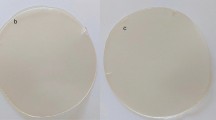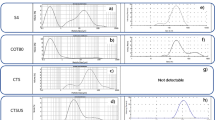Abstract
In this study, antimicrobial edible films incorporated with allyl isothiocyanate in free form (FG-EO) and nanoemulsion form (FG-NE) were produced using the gum obtained from a cold-pressed flaxseed oil by-product (FG). All films were characterized in terms of physicochemical, barrier, mechanical, biodegradability, thermal, and molecular properties. The results showed that integrating allyl isothiocyanate into the films improved the thermal and barrier properties of the films and decreased the tensile strength. According to the molecular characterization, the allyl isothiocyanate antimicrobial compound showed a homogeneous distribution in the film. The FG-EO films and FG-NE films provided strong antimicrobial effect against Escherichia coli O157:H7, Salmonella spp., Listeria monocytogenes, and Staphylococcus aureus pathogenic bacteria at rates ranging from 42 to 87%. Furthermore, during 15-day storage period of fresh-cut meat samples which were packaged with FG-Control, FG-EO, and FG-NE films, significant (P < 0.05) decrease in the number of total mesophile bacteria (TMB), total psychrophile bacteria, and coliform bacteria compared to control fresh-cut meat samples was observed. As a result, it could be said that allyl isothiocyanate incorporated FG-based edible films have the potential as an alternative packaging material to improve the quality of foods and extend the shelf life of fresh-cut meat.





Similar content being viewed by others
References
Pirsa S, Sani IK, Mirtalebi SS (2022) Nano-biocomposite based color sensors: investigation of structure, function, and applications in intelligent food packaging. Food Packag Shelf Life 31:100789
Nurul Fazita M et al (2016) Green composites made of bamboo fabric and poly (lactic) acid for packaging applications—a review. Materials 9(6):435
Sun L et al (2017) Preparation and characterization of chitosan film incorporated with thinned young apple polyphenols as an active packaging material. Carbohyd Polym 163:81–91
Keleş F (2002) Gıda ambalajlama ilkeleri. Atatürk üniversitesi ziraat fak
Vildan E, Tontul İ, Türker S (2020) Edible coating of cereal bars using different biopolymers: effect on physical and chemical properties during storage. Gıda 45(5):1019–1029
Hernandez-Izquierdo V, Krochta J (2008) Thermoplastic processing of proteins for film formation—a review. J Food Sci 73(2):R30–R39
Baldwin EA, Hagenmaier R, Bai J (2011) Edible coatings and films to improve food quality. CRC press
Sani IK et al (2022) Value-added utilization of fruit and vegetable processing by-products for the manufacture of biodegradable food packaging films. Food Chem. https://doi.org/10.1016/j.foodchem.2022.134964
Chen H-H, Xu S-Y, Wang Z (2006) Gelation properties of flaxseed gum. J Food Eng 77(2):295–303
Cui W, Mazza G, Biliaderis C (1994) Chemical structure, molecular size distributions, and rheological properties of flaxseed gum. J Agric Food Chem 42(9):1891–1895
Wang Y et al (2008) Effect of flaxseed gum addition on rheological properties of native maize starch. J Food Eng 89(1):87–92
Khalloufi S et al (2009) Flaxseed gums and their adsorption on whey protein-stabilized oil-in-water emulsions. Food Hydrocoll 23(3):611–618
Salehi B et al (2019) The therapeutic potential of curcumin: a review of clinical trials. Eur J Med Chem 163:527–545
Wang Y et al (2011) Dynamic mechanical properties of flaxseed gum based edible films. Carbohyd Polym 86(2):499–504
Khodaei SM et al (2022) Application of intelligent packaging for meat products: a systematic review. Vet Med Sci. https://doi.org/10.1002/vms3.1017
Eghbaljoo H et al (2022) Advances in plant gum polysaccharides; sources, techno-functional properties, and applications in the food industry-a review. Int J Biol Macromol. https://doi.org/10.1016/j.ijbiomac.2022.10.020
Naji-Tabasi S et al (2016) New studies on basil (Ocimum bacilicum L.) seed gum: part I-fractionation, physicochemical and surface activity characterization. Food Hydrocoll 52:350–358
Bourbon AI et al (2011) Physico-chemical characterization of chitosan-based edible films incorporating bioactive compounds of different molecular weight. J Food Eng 106(2):111–118
Rhim J-W et al (2006) Preparation and characterization of chitosan-based nanocomposite films with antimicrobial activity. J Agric Food Chem 54(16):5814–5822
Jahit I et al (2016) Preparation and physical properties of gelatin/CMC/chitosan composite films as affected by drying temperature. Int Food Res J 23(3):1068–1074
Memiş S et al (2017) Production and characterization of a new biodegradable fenugreek seed gum based active nanocomposite film reinforced with nanoclays. Int J Biol Macromol 103:669–675
Llana-Ruiz-Cabello M et al (2016) Development of PLA films containing oregano essential oil (Origanum vulgare L. virens) intended for use in food packaging. Food Addit Contam: Part A 33(8):1374–1386
Tornuk F et al (2018) Development of LLDPE based active nanocomposite films with nanoclays impregnated with volatile compounds. Food Res Int 107:337–345
Lian M et al (2019) Bi-layered electrospun nanofibrous membrane with osteogenic and antibacterial properties for guided bone regeneration. Coll Surf, B 176:219–229
Tarladgis BG et al (1960) A distillation method for the quantitative determination of malonaldehyde in rancid foods. J Am Oil Chem Soc 37(1):44–48
Bisht AS et al (2017) Studies on development and evaluation of glycerol incorporated cellulose and alginate based edible films. Indian J Agric Biochem 30(1):67–72
Mercer D, Peng P (2008) Solar drying in developing countries: possibilities and pitfalls. Int union food sci technol 11(5):1–11
Akman PK et al (2021) Fabrication and characterization of probiotic lactobacillus plantarum loaded sodium alginate edible films. J Food Meas Charact 15(1):84–92
Bahram S et al (2014) Whey protein concentrate edible film activated with cinnamon essential oil. J Food Process Preserv 38(3):1251–1258
Acevedo-Fani A et al (2015) Edible films from essential-oil-loaded nanoemulsions: physicochemical characterization and antimicrobial properties. Food Hydrocoll 47:168–177
Falguera V et al (2011) Edible films and coatings: structures, active functions and trends in their use. Trends Food Sci Technol 22(6):292–303
Zúñiga R et al (2012) Physical properties of emulsion-based hydroxypropyl methylcellulose films: effect of their microstructure. Carbohyd Polym 90(2):1147–1158
Rubilar JF et al (2015) Physical properties of emulsion-based hydroxypropyl methylcellulose/whey protein isolate (HPMC/WPI) edible films. Carbohyd Polym 123:27–38
Han JH (2005) Innovations in food packaging. Elsevier
Souza ACD et al (2013) Cassava starch composite films incorporated with cinnamon essential oil: antimicrobial activity, microstructure, mechanical and barrier properties. LWT-Food Sci Technol 54(2):346–352
Kavoosi G et al (2014) Effects of essential oil on the water binding capacity, physico-mechanical properties, antioxidant and antibacterial activity of gelatin films. LWT-Food Sci Technol 57(2):556–561
Boonruang K, et al (2016) Antifungal poly (lactic acid) films containing thymol and carvone. In: MATEC web of conferences. EDP sciences
Mahcene Z et al (2020) Development and characterization of sodium alginate based active edible films incorporated with essential oils of some medicinal plants. Int J Biol Macromol 145:124–132
Hosseini SF et al (2013) Preparation and functional properties of fish gelatin–chitosan blend edible films. Food Chem 136(3–4):1490–1495
Pérez-Gago MB, Krochta JM (2001) Lipid particle size effect on water vapor permeability and mechanical properties of whey protein/beeswax emulsion films. J Agric Food Chem 49(2):996–1002
Jouki M et al (2014) Characterization of antioxidant–antibacterial quince seed mucilage films containing thyme essential oil. Carbohyd Polym 99:537–546
Zhou Y et al (2021) Effects of cinnamon essential oil on the physical, mechanical, structural and thermal properties of cassava starch-based edible films. Int J Biol Macromol 184:574–583
Hosseini SF et al (2015) Bio-based composite edible films containing Origanum vulgare L. essential oil. Ind Crops prod 67:403–413
Sun H et al (2020) Antibacterial and antioxidant activities of sodium starch octenylsuccinate-based pickering emulsion films incorporated with cinnamon essential oil. Int J Biol Macromol 159:696–703
Bonilla J et al (2013) Effect of the incorporation of antioxidants on physicochemical and antioxidant properties of wheat starch–chitosan films. J Food Eng 118(3):271–278
Nisar T et al (2018) Characterization of citrus pectin films integrated with clove bud essential oil: physical, thermal, barrier, antioxidant and antibacterial properties. Int J Biol Macromol 106:670–680
Espitia PJP et al (2014) Optimal antimicrobial formulation and physical–mechanical properties of edible films based on açaí and pectin for food preservation. Food Packag Shelf Life 2(1):38–49
Liang S et al (2017) H2O2 oxidative preparation, characterization and antiradical activity of a novel oligosaccharide derived from flaxseed gum. Food Chem 230:135–144
Liu Y et al (2017) Improved antioxidant activity and physicochemical properties of curcumin by adding ovalbumin and its structural characterization. Food Hydrocoll 72:304–311
Fang S et al (2020) Effect of sonication on the properties of flaxseed gum films incorporated with carvacrol. Int J Mol Sci 21(5):1637
Shin K et al (2007) Crystalline structures, melting, and crystallization of linear polyethylene in cylindrical nanopores. Macromolecules 40(18):6617–6623
Robertson GL (2005) Food packaging: principles and practice. CRC press
Debandi MV, Bernal CR, Francois N (2016) Development of biodegradable films based on chitosan/glycerol blends suitable for biomedical applications
Hay Y-O et al (2018) Evaluation of combinations essential oils and with evaluation of combinations essential oils and with hydrosols on antimicrobial and antioxidant activities. J Pharm Pharmacogn Res 6(3):216–230
Wattananawinrat K, Threepopnatkul P, Kulsetthanchalee C (2014) Morphological and thermal properties of LDPE/EVA blended films and development of antimicrobial activity in food packaging film. Energy Proced 56:1–9
Oulkheir S et al (2017) Antibacterial activity of essential oils extracts from cinnamon, thyme, clove and geranium against a gram negative and gram positive pathogenic bacteria. J dis med plants 3(2–1):1–5
Eker B (2017) TEKİRDAĞ KÖFTESİNİN FARKLI ORANLARDA JELATİN, GLİSEROL VE KEKİK EKSTRAKTI İÇEREN ÇÖZELTİ İLE KAPLANMASININ RAF ÖMRÜNE ETKİSİNİN ARAŞTIRILMASI
İncili GK et al (2021) Characterization of pediococcus acidilactici postbiotic and impact of postbiotic-fortified chitosan coating on the microbial and chemical quality of chicken breast fillets. Int J Biol Macromol 184:429–437
Klebanov G et al (1998) The antioxidant properties of lycopene. Membr Cell Biol 12(2):287–300
Fang S et al (2019) Antimicrobial carvacrol incorporated in flaxseed gum-sodium alginate active films to improve the quality attributes of Chinese sea bass (Lateolabrax maculatus) during cold storage. Molecules 24(18):3292
Author information
Authors and Affiliations
Corresponding author
Additional information
Publisher's Note
Springer Nature remains neutral with regard to jurisdictional claims in published maps and institutional affiliations.
Rights and permissions
Springer Nature or its licensor (e.g. a society or other partner) holds exclusive rights to this article under a publishing agreement with the author(s) or other rightsholder(s); author self-archiving of the accepted manuscript version of this article is solely governed by the terms of such publishing agreement and applicable law.
About this article
Cite this article
Kopuz, S., Akman, P.K., Tekin-Cakmak, Z.H. et al. Development and characterization of antimicrobial films from gums obtained from cold-pressed flaxseed oil by-product. Polym. Bull. 81, 1767–1787 (2024). https://doi.org/10.1007/s00289-023-04793-7
Received:
Revised:
Accepted:
Published:
Issue Date:
DOI: https://doi.org/10.1007/s00289-023-04793-7




